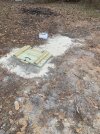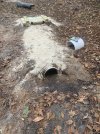TristonH
New Member
To preface: I've recently been given a gopher tortoise, and just built an outdoor burrow for it. It is a regulated species, and I do have a permit, just so that doesn't come up. I took a look at another outdoor enclosure at a nature center near by, and used theirs to plan my own based upon what I did, and didn't like. Regrettably, I didn't know about this forum until after I built the thing. I could have leaned on the expertise of the numerous build plans here, but hindsight.
I followed the nature center's example by building a burrow box at the end of a tunnel leading from the surface. the box is 2.5ft deep, with a hatch door on top so that I can get her out and check on her if I need to. The goal was to mimic a natural burrow that she would have in the wild. In any case, she's not living in there yet, I still need to build the fence around it for her actual pen, but I've hung a remote thermometer/hygrometer in there that records temp and humidity data every few minutes, and it's not getting as warm as I'd like. It was sitting right at 50 degrees Fahrenheit, day and night. Which was warmer than our recent night-time temps, but cooler than our daytime temps. I insulated the hatch door yesterday, and that helped a little, raising it to about 53 degrees. Ideally it would be in the low 60's this time of year to mimic a wild burrow. I suspect that during the warmer months this will become less of an issue, because it's shaded.
So my question, do any of you know of any heating products that I can add that is waterproof, and would just serve to help raise the temperatures in the box. It's a small box, so I wouldn't need much heat. to bring the ambient temps up to my target of low 60's. I searched through the forum a good bit, and found mention of the Big Apple Herp heat cable, but I couldn't find that product online, I'm not sure if they're still selling them. I also found reference to the reptile basics radiant heat panel, which I think would work just fine, but they're sold out for the moment. So does anyone know of other products that might work? Waterproof is a must, as it does rain frequently here in South Georgia, and I'd also like something I can leave in there year-round, even If I only need to turn it on for a few months during the year.
I followed the nature center's example by building a burrow box at the end of a tunnel leading from the surface. the box is 2.5ft deep, with a hatch door on top so that I can get her out and check on her if I need to. The goal was to mimic a natural burrow that she would have in the wild. In any case, she's not living in there yet, I still need to build the fence around it for her actual pen, but I've hung a remote thermometer/hygrometer in there that records temp and humidity data every few minutes, and it's not getting as warm as I'd like. It was sitting right at 50 degrees Fahrenheit, day and night. Which was warmer than our recent night-time temps, but cooler than our daytime temps. I insulated the hatch door yesterday, and that helped a little, raising it to about 53 degrees. Ideally it would be in the low 60's this time of year to mimic a wild burrow. I suspect that during the warmer months this will become less of an issue, because it's shaded.
So my question, do any of you know of any heating products that I can add that is waterproof, and would just serve to help raise the temperatures in the box. It's a small box, so I wouldn't need much heat. to bring the ambient temps up to my target of low 60's. I searched through the forum a good bit, and found mention of the Big Apple Herp heat cable, but I couldn't find that product online, I'm not sure if they're still selling them. I also found reference to the reptile basics radiant heat panel, which I think would work just fine, but they're sold out for the moment. So does anyone know of other products that might work? Waterproof is a must, as it does rain frequently here in South Georgia, and I'd also like something I can leave in there year-round, even If I only need to turn it on for a few months during the year.


